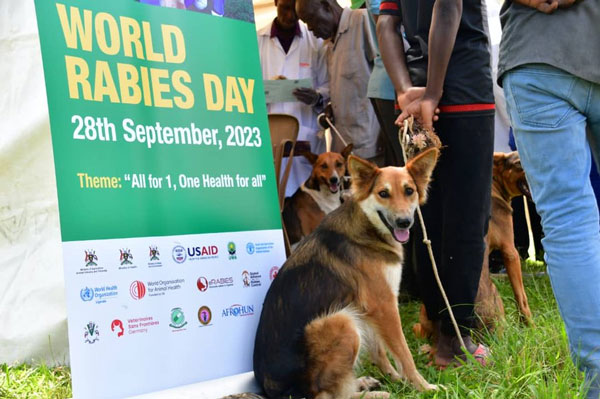
Dog bites and scratches account for more than 99% of human rabies cases, with most of the victims being children aged below 15 years
SPECIAL FEATURE | Dr Jesse Mukisa Mutesasira | Rabies is a zoonotic viral disease that affects warm-blooded animals — humans inclusive. The disease has two cycles; the wild (sylvatic) and then the domestic, which happen with man’s first animal friend – the dog – as the biggest link.
The disease is 100 % fatal in humans from the moment clinical signs are manifested. It has a latency period that varies from a few weeks to several years.
It remains listed as a neglected tropical disease (NTD) mainly in Africa and Asia with thousands of lives lost yearly. NTD is a humble term used to mean diseases of the poor as the disease is 100 percent preventable and many countries have actually eradicated and eliminated the disease.

The first aid to a dog bite or scratch is washing the wound with plenty of running water and soap for 15 -20 minutes, then seeking professional medical help.
Dog bites and scratches account for more than 99% of human rabies cases, with most of the victims being children aged below 15 years. Any age group is however susceptible and at risk.
Recently an innocent Ugandan soul, whose future was yet to be determined, was taken from us in Kabale district.
This innocent primary school child was reported to have been attacked and bitten by a dog but the poor parents not being well informed on what to do, never gave the attention this incident deserved. A few weeks later, the child exhibited nervous signs associated with rabies and finally a life of Ugandan was lost. This story only came to light because it eventually got media coverage. This leaves me wondering how many such cases go unnoticed. Are we not therefore normalizing preventable deaths?
Dr Ian Clarke’s insights in a Sunday Vision article on April 10 2022, titled “Why do Ugandans die young?” now makes full sense to any readers.
The tales of veterinarian in dealing with rabies a silent killer
I first had a chance to interface with a suspected rabies case in 2022 when a farmer gave me a call in the night and reported how one of his puppies had become aggressive in the kennel, and bitten the sibling. I asked him whether they were still locked up and he said yes.
This gave me a breather and I kindly requested him not to open up for them since it was late, and he was 20km plus away from me. I explained to him the suspected disease must be rabies and that I was to go there the next day to collect samples for laboratory submission and confirmation.
The next day I struggled with the cold chain facility to ensure the sample remained viable, got on the motorcycle and used the locally available resources to try to get the brain sample from the dog.
With God’s grace I succeeded. However, during the process I got an accidental exposure to the brain tissue and fluids. Stunned, I knew I had to remain composed.
I requested some soap and water to flush my eyes where the spill had gotten to. I then got my cool box dropped in the sample and rushed to prepare my self to deliver it to the National Animal Disease Diagnostic and Epidemiology Centre (NADDEC) in Entebbe.
Even before I arrived, I communicated to the Entebbe team the difficulty I faced, as I was coming from far and I was to use public transport.
I had been exposed and now got to understand what a common Ugandan goes through to get post-exposure prophylaxis (PEP) for rabies.
On reaching Kampala, I visited Kirudu hospital where it was suggested is where victims should go. The only thing I got from there was the PEP prophylaxis form, so I proceeded to NADDEC where a great man received me despite having got there past 5pm.
He ran the rapid diagnostic test that came out positive for rabies. A more specific test, whose results would take days, was also to be run on the sample.

With this evidence, I started imagining and feeling the rabies signs.
I rushed to Entebbe Grade B hospital where I was told the unit handling rabies had closed, and I should return the next day.
By 7am the next day, I was at the hospital, and I was told the government-supplied PEP was out of stock as doses are usually limited versus the patients the hospital receives.
So, I had to be treated via the private wing and religiously took all my 5 shots in the one-month window.
On my third visit, I was met an actual rabies victim who had come to the hospital and during my interaction with him, said he had been bitten by a stray dog in Mityana a month ago. This gentleman was sweating, complaining of stomach pain, had labored breathing, plus signs of hypersalivation.
The pain was much in that they had even tied a piece of cloth around his waist.
The hospital was trying to keep him on intravenous fluids and working on his referral to Mulago hospital for further management.
It is such a pain to see lives being lost to preventable diseases.
World Rabies Day is commemorated on September 28th every year in memory of the great scientist Louis Pasteur, who discovered the rabies vaccine in 1885.
This reminds me that this year’s national event was held in Kasese district under the leadership of the Ministry of Agriculture, Animal Industries and Fisheries (MAAIF) with a theme “Breaking Rabies Boundaries.”
The World has a global target of eliminating dog-mediated rabies by 2030 and as a country, the National Rabies Elimination Strategy is in place. However, the implementation faces various gaps, including financial commitment, with only a few years left to 2030.
My request to you reading this article is, let us all have our dogs and cats annually vaccinated against rabies by a qualified and licensed veterinarian. For practicing veterinarians, please ensure you are vaccinated against rabies when the exposure happens.
Let’s work together to eliminate rabies as every Ugandan life is precious and should be protected.
******
Jesse Mukisa Mutesasira | Veterinarian/Vice President Uganda Veterinary Association Eastern Chapter/Uganda National Animal Health Network-One Health Representative | Email: jessemukisabryt@gmail.com
 The Independent Uganda: You get the Truth we Pay the Price
The Independent Uganda: You get the Truth we Pay the Price



